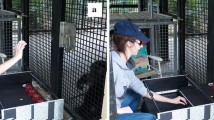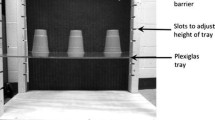Abstract
This study investigated capuchin monkeys' understanding of their own visual search behavior as a means to gather information. Five monkeys were presented with three tubes that could be visually searched to determine the location of a bait. The bait's visibility was experimentally manipulated, and the monkeys' spontaneous visual searches before tube selection were analyzed. In Experiment 1, three monkeys selected the baited tube significantly above chance; however, the monkeys also searched transparent tubes. In Experiment 2, a bent tube in which food was never visible was introduced. When the bent tube was baited, the monkeys failed to deduce the bait location and responded randomly. They also continued to look into the bent tube despite not gaining any pertinent information from it. The capuchin monkeys' behavior contrasts with the efficient employment of visual search behavior reported in humans, apes and macaques. This difference is consistent with species-related variations in metacognitive abilities, although other explanations are also possible.



Similar content being viewed by others
References
Bower TGR (1982) Development in infancy, 2nd edn. Freeman, San Francisco
Call J, Carpenter M (2001) Do apes and children know what they have seen? Anim Cogn 4:207–220
Dumas C, Brunet C (1994) Object permanence in capuchin monkeys: a study of invisible displacements. Can J Exp Psychol 48:341–358
Flavell JH, Green FL, Herrera C, Flavell ER (1991) Young children's knowledge about visual perception: lines of sight must be straight. Brit J Dev Psychol 9:73–87
Fragaszy DM, Johnson-Pynn J, Hirsh E, Brakke K (2003) Strategic navigation of two-dimensional alley mazes: comparing capuchin monkeys and chimpanzees. Anim Cogn 6:149–160
Fragaszy DM, Visalberghi E, Fedigan LM (2004) The complete capuchin. Cambridge University Press, Cambridge
Fujita K, Kuroshima H, Asai S (2003) How do tufted capuchin monkeys (Cebus apella) understand causality involved in tools? J Exp Psychol: Anim Behav Process 29:233–242
Goldman AI (1993) The psychology of folk psychology. Behav Brain Sci 16:15–28
Gordon RM (1986) Folk psychology as simulation. Mind and Lang 1:158–171
Griffin DR (2003) Significant uncertainty is common in nature. Behav Brain Sci 26:346
Hampton RR (2001) Rhesus monkeys know when they remember. Proc Natl Acad Sci 98:5359–5362
Hampton RR, Zivin A, Murray EA (2004) Rhesus monkeys (Macaca mulatta) discriminate between knowing and not knowing and collect information as needed before acting. Anim Cogn 7:239–246
Inman A, Shettleworth SJ (1999) Detecting metamemory in nonverbal subjects: a test with pigeons. J Exp Psychol: Anim Behav Process 25:389–395
Kuroshima H, Fujita K, Fuyuki A, Masuda T (2002) Understanding of the relationship between seeing and knowing by tufted capuchin monkeys (Cebus apella). Anim Cogn 5:41–48
Kuroshima H, Fujita K, Adachi I, Iwata K, Fuyuki A (2003) A capuchin monkey (Cebus apella) recognizes when people do and do not know the location of food. Anim Cogn 6:283–291
McGonigle B, Chalmers M, Dickinson A (2003) Concurrent disjoint and reciprocal classification by Cebus apella in seriation tasks: evidence for hierarchical organization. Anim Cogn 6:185–197
Nelson TO, Narens L (1990) Metamemory: a theoretical framework and new findings. In: Bower G (ed) The psychology of learning and motivation. Academic Press, New York, pp. 125–173
Povinelli DJ, Vonk J (2003) Chimpanzee minds: suspiciously human? Trends Cogn Sci 7:157–160
Schrier AM (1983) Eye movements of stumptailed monkeys during discriminative performance: an overview. Int J Primatol 4:373–381
Smith JD, Schull J, Strote J, McGee K, Egnor R, Erb L (1995) The uncertain response in the bottlenosed dolphin (Tursiops truncatus). J Exp Psychol: Anim Behav Process 124: 391–408
Smith JD, Shields WE, Washburn DA (2003) The comparative psychology of uncertainty monitoring and metacognition. Behav Brain Sci 26:317–373
Visalberghi E, Limongelli L (1994) Lack of comprehension of cause-effect relations in tool-using capuchin monkeys (Cebus apella). J Comp Psychol 108:15–22
Acknowledgements
This work was supported by the Japanese Ministry of Education, Culture, Science, Sports, and Technology (MEXT) through Grant in Aid for Scientific Research No. 13410026 to K. Fujita, and the 21st Century Center of Excellence Program (D-10) to Kyoto University. The experiments in this paper complied with the Guide for the care and use of laboratory primates, Primate Research Institute, Kyoto University, and the current Japanese laws on animal experimentation.
Author information
Authors and Affiliations
Corresponding author
Rights and permissions
About this article
Cite this article
Paukner, A., Anderson, J.R. & Fujita, K. Redundant food searches by capuchin monkeys (Cebus apella): a failure of metacognition?. Anim Cogn 9, 110–117 (2006). https://doi.org/10.1007/s10071-005-0007-2
Received:
Revised:
Accepted:
Published:
Issue Date:
DOI: https://doi.org/10.1007/s10071-005-0007-2




